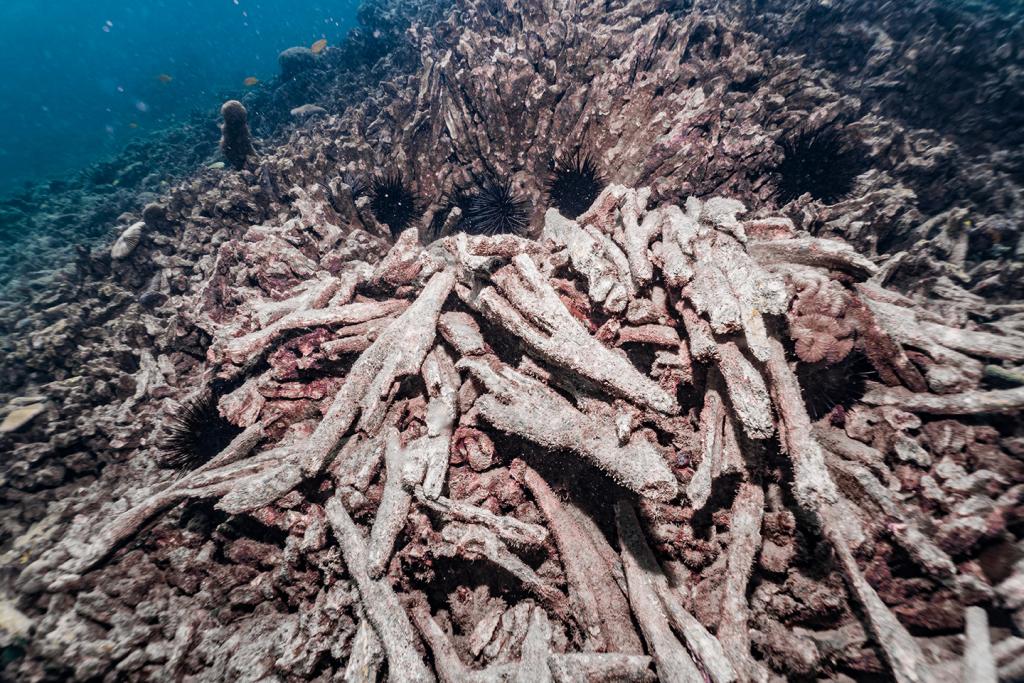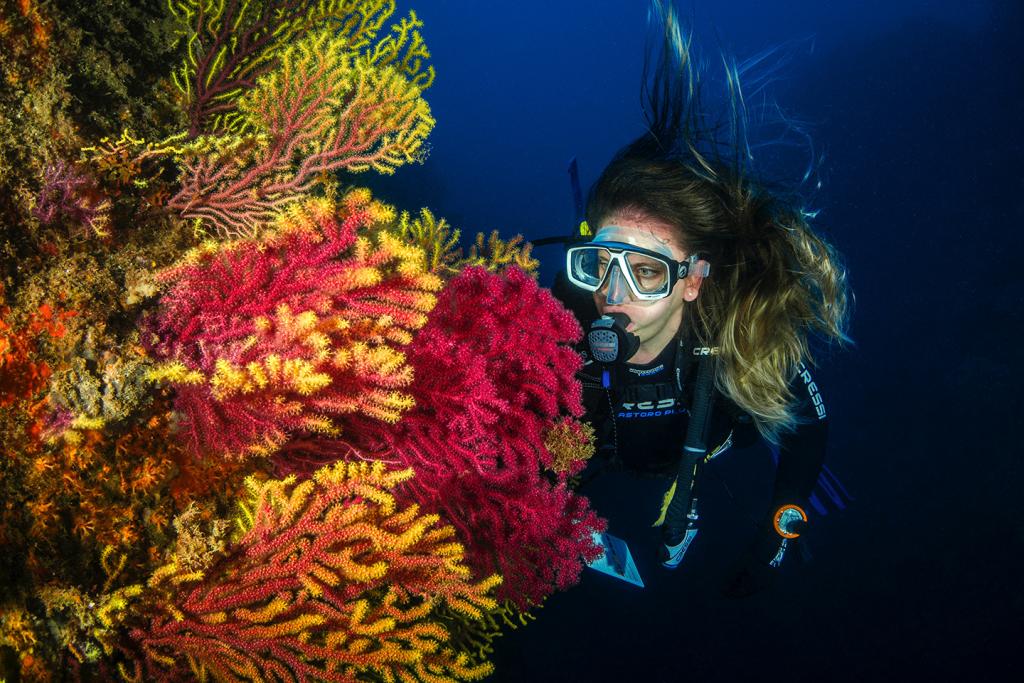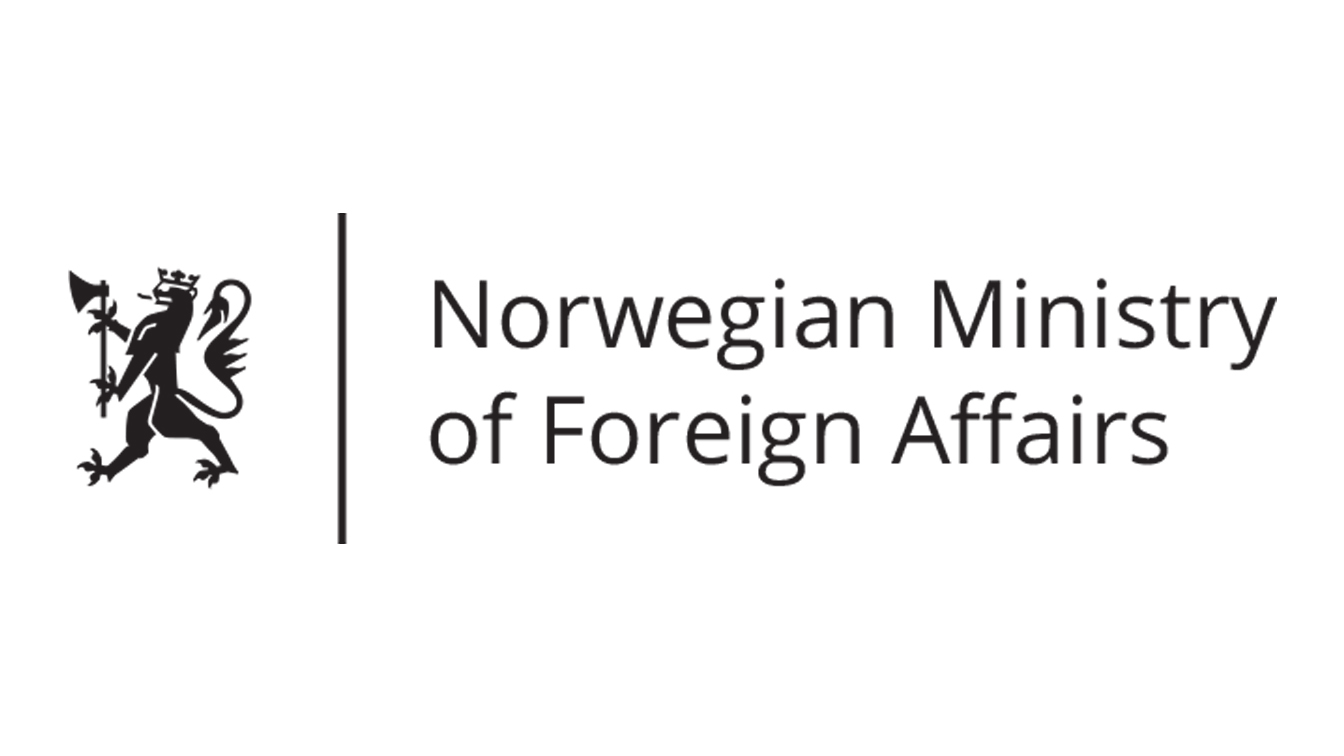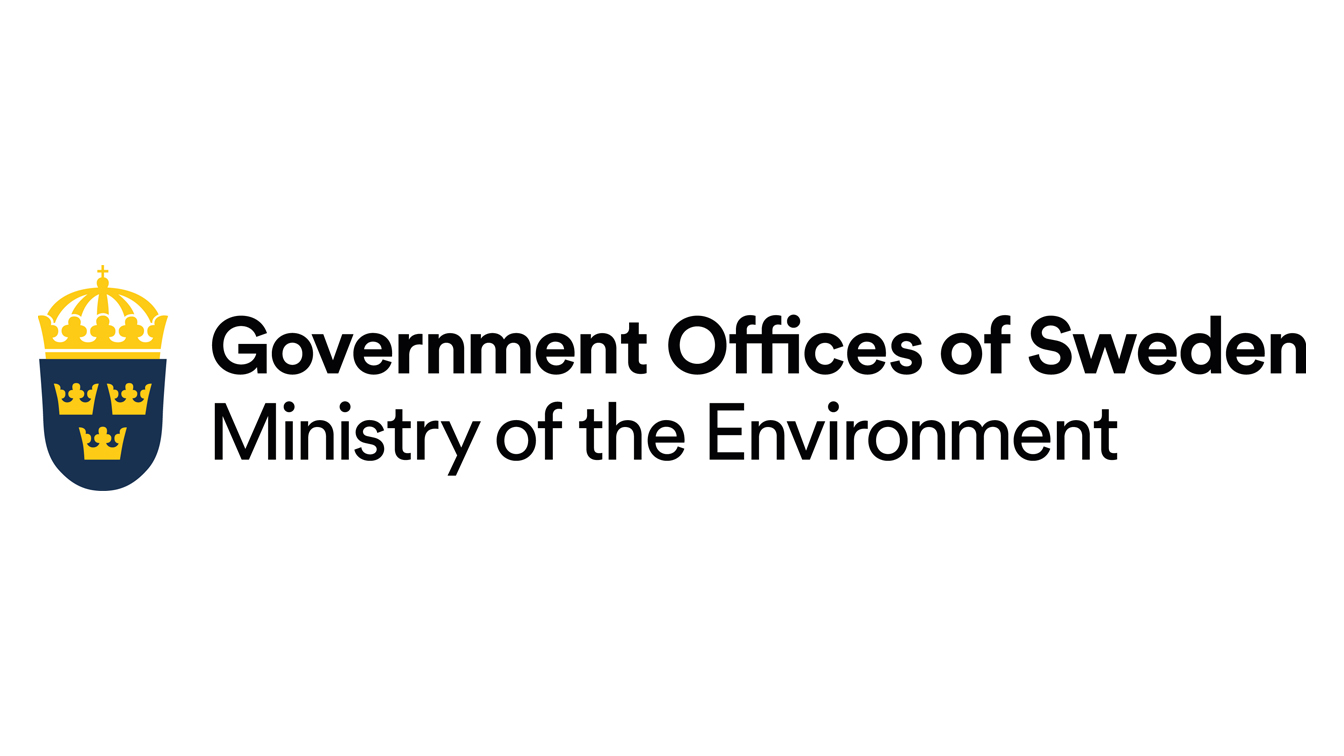Coral Reefs: Strategies for Ecosystems on the Edge
Still Only One Earth: Lessons from 50 years of UN sustainable development policy
Coral reefs have exceptional levels of biodiversity and provide important social and ecological services, including food, coastal protection, recreation, tourism, and cultural connections. However, local stressors and climate change are causing a sharp decline in coral reefs and the more than 230 international agreements with coral reef provisions have failed to protect these “rainforests of the sea.” (Download PDF) (See all policy briefs) (Subscribe to ENB)
Coral reefs are among the most vulnerable ecosystems on the planet. Often called the “rainforests of the sea,” they are rich in biodiversity and provide major benefits to humankind. And yet corals remain an enigma to many, who may not even realize they are living organisms.
Cylindrically shaped, soft-bodied, and close cousins to anemones and jellyfish, corals are the architects of the reef. Hard or stony corals secrete calcium carbonate, creating their own homes along with three-dimensional foundations that host a myriad of life. Individual coral polyps grow on top of ancestral skeletons, forming interconnected colonies. Soft corals are also part of the reef system but aren’t builders; their polyp colonies form structures that look like trees, fans, whips, and grasses.
Coral species are diverse, interdependent, and ancient, first appearing 500 million years ago. Growth rings of a particular deep-sea coral mark its age at 4,000 years—the oldest known living marine organism (Lawrence Livermore National Laboratory, 2009). The majority of the world’s six thousand coral species occur in warm, shallow seas, where the photosynthesizing symbiont algae called zooxanthellae supply corals with essential nutrients and give them their colour. In deeper, darker waters, corals rely on their stinging tentacles to snag food from the inky blackness.
Coral colonies cover a tiny fraction of the ocean floor, yet nearly a quarter of all marine species depend on reef ecosystems for refuge and sustenance off the coasts of 100 countries or territories. An estimated one million aquatic plant and animal species use healthy reefs for feeding, spawning, and nursery grounds.
Only one species—Homo sapiens—has shown the ability to destroy them.
Global Threats and Local Stressors
“Standing in knee-deep water, I stuck my face in and had a pufferfish staring back at me. There were fish all around me.” A long-time marine educator described her first experience at the largest intact fringing reef in Hawai‘i—a type of reef that grows seaward from the shore. Lobe coral lined a wide, oatmeal-coloured sand channel, creating a golden corridor that led to deeper waters and even more diversity. Three decades later, she lamented, “It looks like a ghost town.” (Penniman, 2019).
Environmental stresses, especially higher water temperatures, can cause corals to expel their colour-inducing symbionts. The symbiotic algae transfer up to 90% of the energy they produce through photosynthesis to coral tissue (NOAA, n.d.). Coral bleaching is one of the most visible signs reefs are in trouble: without their beneficial algae, the corals begin to starve. Bleaching does not always signal death, but repeated episodes can leave swaths of reef unable to recover. Large-scale bleaching events were unreported in scientific literature before 1979 (Hoegh-Guldberg et al., 2017), but now are increasing in intensity and frequency. Between 2014 and 2017, an unprecedented ocean heat wave caused bleaching at more than 75% of the world’s tropical reefs; death ensued at nearly one-third of them. Mass bleaching events are now estimated to occur about every six years (Eakin et al., 2018).
I find it incredibly difficult to imagine a world without coral reefs, but that is essentially what the IPCC has forecast will be the case once we go through the dreaded line of 2° Celsius global warming.
Ocean acidification is another reef stressor. Increased levels of carbon dioxide generated by greenhouse gas emissions are making the ocean more acidic and affecting the ability of corals to grow their skeletons. Ocean acidity has increased by 30% over the last 200 years, faster than any known change in ocean chemistry in 50 million years (Smithsonian, 2018). Like nutritional deficiencies that cause osteoporosis in humans, reduced levels of carbonate ions in ocean water result in thinner coral skeletons, making them less resistant to pounding waves (Mollica et al., 2018). By the end of this century, coral reefs could dissolve and erode more quickly than they grow.

A warming climate profoundly impacts coral reefs: an increase in average global temperature of 1.5°C above pre-industrial levels is projected to cause the decline of 70 to 90% of coral reefs. All coral reefs would disappear with a 2°C increase (IPCC, 2018).
Other threats originate closer to home, including: overfishing; destructive fishing practices, such as use of dynamite or poisons; coastal development; sedimentation, including from inland deforestation; land-based pollutants or sewage; pollution from commercial, recreational, and passenger vessels; and the introduction of marine invasive species. Deep-sea corals face additional harm from oil and gas exploration and bottom trawling, which drags weighted fishing nets across the sea floor.
Socioeconomic Benefits: Reefs Deliver
Despite our ill treatment of this resource, humans are dependent on healthy reef ecosystems. An estimated 40% of the world’s population lives within 100 km of the coast—nearly 2.4 billion people. The livelihoods of six million commercial and subsistence fishers depend on coral reefs. Coral reef ecosystems also provide income from recreation and tourism activities, and shoreline protection—socio-economic benefits estimated to exceed USD 20 billion annually (Spalding et al., 2017; UNEP et al., 2018).

While the loss of coral reef ecosystems has global implications, the socio-economic impacts are disproportionate: most coral reefs are in the waters off developing countries, including some classified as least developed countries (WRI, 2011). Impacts are likely compounded for women and Indigenous Peoples who may experience limited access to fishing grounds, boats, equipment, financing, and education (Österblom et al., 2020).
The loss of coral reefs threatens traditional practices and a way of life passed down over generations: the satisfaction of a well-thrown net or cast of line; knowledge of a place, seasons, and species; and immersion in a world so different from the land we live on. In many coastal cultures, the reef is considered family, a connection that carries with it a deep sense of responsibility to care for and protect it.
Locally Sourced Solutions
Efforts to address local stressors have helped reduce coral reef vulnerability to climate change and highlight the value of focusing on resilience (Maynard et al., 2018). Success stories include community-based programs and protective laws:
- Belize: a ban on harvesting algae-eating parrotfish improved coral cover
- Bali: local reef tour guides help keep resources in the community and increase commitments for reef protection
- American Samoa: fishing restrictions and waste diversions led to coral recovery after a crown-of-thorns outbreak decimated coral reefs
- United States: a ban in Hawai‘i on the sale of sunscreen containing coral-harming chemicals
Selected Global Targets related to Coral Reef Ecosystems
Climate change
- Global warming: limit to well below 2°C and pursue efforts to limit to 1.5°C. [Paris Agreement]
- Food production: increase ability to adapt to adverse impacts and foster climate resilience [Paris Agreement]
Production from living resources
- Threatened species: prevent extinction of known threatened species and improve and sustain their conservation status [Aichi Biodiversity Targets]
- Fishing practices: effectively regulate harvesting and end overfishing, illegal, unreported and unregulated fishing, and destructive fishing practices [2030 Agenda]
- Small island developing states (SIDS) and least developed countries (LDCs): increase economic benefits to SIDS and LDCs from the sustainable use of marine resources, including through sustainable management of fisheries, aquaculture, and tourism [2030 Agenda]
- Small-scale artisanal fishers: provide access to marine resources and markets. National legal/regulatory/policy/institutional frameworks recognize and protect access rights for small-scale fisheries [2030 Agenda]
Generation of land-based sources of pollution
- Pollution: pollution levels are not detrimental to ecosystem function and biodiversity [Aichi Targets]
- Marine pollution: prevent and significantly reduce marine pollution, including marine debris and nutrient pollution [2030 Agenda]
- Sewage and waste: sewage, waste waters and solid wastes disposed in conformity with national or international environmental quality guidelines [GPA]
Extraction of non-living resources
- Sustainable production and consumption: keep impacts of use of natural resources well within safe ecological limits [Aichi Targets]
Tourism and recreation
- SIDS and LDCs: increase economic benefits to SIDS and LDCs from the sustainable use of marine resources, including through sustainable management of fisheries, aquaculture and tourism [2030 Agenda]
Multiple anthropogenic drivers
- Climate change and ocean acidification: multiple anthropogenic pressures on coral reefs are minimized to maintain integrity and functioning [Aichi Targets]
- Marine and coastal ecosystems: sustainable management and protection to avoid significant adverse impacts, including by strengthening resilience, and restoration actions [2030 Agenda]
- Coastal and marine areas: conserve at least 10% of coastal and marine areas, consistent with national and international law and [2030 Agenda]
Based on Box 4. Selected Global Targets to Address Anthropogenic Drivers of Change in Coral Reef Ecosystems, found within International Reef-Related Instruments (UNEP, 2019).
International Awareness and Strategies
Global problems require global solutions. Forests, endangered species, wetlands, and migratory species all benefit from global agreements focused on their conservation and sustainable use—but not coral reefs. Instead, international efforts to protect coral reef ecosystems have developed incrementally since the 1960s. Marine-related provisions in the 1972 Stockholm Declaration and Action Plan focused on pollution and fisheries, with no explicit reference to coral reefs. Since then, coral reef concerns have been incorporated into 150 global instruments. Of these, 32 are legally binding, with the rest considered voluntary. An additional 82 regional agreements include coral reef provisions (UNEP, 2019).
The collective scope of these agreements (see Box 1) covers almost every anthropogenic driver of change in coral reef ecosystems, with 600 discrete targets for action that are measurable and timebound. For most of the commitments, implementation lies with individual states. These agreements include:
1982 UN Convention on the Law of the Sea (UNCLOS): UNCLOS establishes the overarching sovereign rights and obligations of states within defined maritime zones, including the rights to explore, exploit, conserve, and manage the living and non-living natural resources under their jurisdiction. UNCLOS sets the overall framework for coral reef-related actions by Member States within their exclusive economic zones.
1971 Ramsar Convention: Approximately 850 of the 2,400 Ramsar sites on the list of Wetlands of International Importance contain coral reefs. Key activities supported by the Convention include advisory missions, a mechanism for sharing global expertise, and initiatives that promote scientific and technical cooperation and exchange of knowledge on wetlands-related issues in specific regions.
1972 World Heritage Convention: This treaty focuses on the preservation of cultural sites and the conservation of nature. Five coral reefs are inscribed on the World Heritage List: Rock Islands Southern Lagoon (Palau), the Lagoons of New Caledonia (France), Belize Barrier Reef Reserve System (Belize), Ningaloo Coast (Australia), and the Great Barrier Reef (Australia).
1973 Convention on the International Trade in Endangered Species of Wild Fauna and Flora (CITES): International trade in reef “products” is driven by the aquarium trade for live organisms, and curio and jewelry markets for dead coral. Stony corals, blue corals, organ pipe corals, and fire corals are listed on CITES Appendix II; these are not threatened with extinction, but their trade must be controlled to ensure their survival.
1979 Convention on the Conservation of Migratory Species of Wild Animals (CMS): CMS Appendix I species that are significantly dependent on inter-tidal and other associated coastal habitats include seven marine mammals, 40 bird species, six turtles, and eleven species of fish. Appendix I species face a very high risk of extinction and the taking of species is prohibited with limited exceptions.
1992 Convention on Biological Diversity (CBD): Coral reef-related actions under the CBD include:
- the 1995 Jakarta Mandate, which led to a programme of work on coastal and marine biodiversity
- the 2011–2020 Strategic Plan for Biodiversity, including the Aichi Targets, focused on sustainable fisheries, minimizing anthropogenic pressures caused by climate change or ocean acidification, and conserving at least 10% of coastal and marine areas
- integrated marine and coastal area management
- identifying ecologically or biologically significant marine areas (EBSAs) to prioritize management efforts
- support for networks of marine and coastal protected areas
- the Sustainable Ocean Initiative, which enhances the capacity of countries for marine conservation and sustainable development
1992 UN Framework Convention on Climate Change (UNFCCC) and 2015 Paris Agreement: The survival of coral reef ecosystems depends on meeting the goals set forth in the Paris Agreement —to hold the increase in global average temperature to well below 2°C above pre-industrial levels and to pursue efforts to limit the increase to 1.5°C.
Other Relevant Agreements and Initiatives
The 2030 Agenda for Sustainable Development, which was adopted in 2015, includes 17 Sustainable Development Goals (SDGs) and 169 targets. SDG 14 seeks to “conserve and sustainably use the oceans, seas and marine resources for sustainable development.” SDG 14 targets relevant to coral reefs address: marine pollution; ocean acidification; overfishing, illegal, underreported and unregulated fishing (IUU), and destructive fishing; conserving at least 10% of coastal and marine areas; and increasing economic benefits to small island developing states (SIDS) and least developed countries (LDCs) from sustainable use of marine resources.
The United Nations Environment Programme (UNEP) hosts other international agreements that have elements that affect coral reef ecosystems. UNEP’s Regional Seas Programme promotes sustainable management and use of the marine and coastal environment by engaging countries to implement specific actions to protect shared marine resources. UNEP’s Global Programme of Action for the Protection of the Marine Environment from Land-based Activities focuses on marine litter, nutrient management, and wastewater through global multi-stakeholder partnerships.
The International Coral Reef Initiative (ICRI) is an informal partnership between nearly 90 countries and organizations. ICRI’s Framework for Action provides high-level guidance to governments and other stakeholders to implement management strategies and actions based on global best practices in four main areas: integrated management; capacity building; science and monitoring; and periodic assessment.
Present Status and Options for the Future
The provisions on coral reefs in so many different international agreements suggests both global recognition of their importance, and how integral these ecosystems are to biodiversity goals, other ecosystems, and at-risk species. But is this patchwork approach working?
The UNEP analysis of global and regional coral reef policy instruments and governance mechanisms sought to answer this question (UNEP, 2019). The analysis concluded the existing agreements cover the scope of actions needed to address local drivers of reef loss and enhance coral reef resilience but noted half of the 600 commitments are nonbinding. UNEP posited that competing demands and a lack of incentives and appropriate financial mechanisms may be hindering implementation of these commitments. In other words, the global community knows what needs to be done, but implementation is lacking.

What Can Be Done?
A binding global agreement on coral reef protection could help elevate coral reefs on the international stage, bolster political will for implementation, establish a financing mechanism, and provide a framework to integrate existing indicators and commitments. But multilateral agreements take time and resources. The current track record for implementation and the perilous condition of coral reefs suggest another treaty might not be the best way to effect necessary changes.
Other options identified by the 2019 UNEP analysis include: accelerating implementation; strengthening the existing international policy framework; and rapid support to states for policy implementation, dubbed “the coral reef-state solution.” Recent developments indicate progress on these options.
Today, the question is no longer whether these extraordinary ecosystems will be damaged but to what extent they will be. It is also to anticipate what will be irreparably lost of their diversity and to assess the consequences for tropical countries as for all of humanity.
In September 2020, the Global Fund for Coral Reefs (GFCR) launched a new fund seeking to raise and invest USD 500 million in coral reef conservation over the next ten years. This initiative includes public, philanthropic, and private actors, highlighting the potential of unique partnerships to advance coral reef protection and SDG 14. In 2021, the GFCR announced its first round of funding for six different countries.
In December 2020, the High Level Panel for a Sustainable Ocean Economy committed to achieving 100% sustainable ocean management of areas within their national jurisdiction by 2025. Established in 2018, the Ocean Panel is a policy body of world leaders from 14 countries with diverse economies, spread across ocean basins: Australia, Canada, Chile, Fiji, Ghana, Indonesia, Jamaica, Japan, Kenya, Mexico, Namibia, Norway, Palau, and Portugal. Participating countries account for 41% of the world’s warm-water reefs (UNEP-WCMC, 2001). The direct involvement of Heads of State in the Ocean Panel suggests the political will exists to effect change.
While these developments offer hope, climate change remains the single greatest threat to coral reefs. The year 2020 tied with 2016 for the planet’s warmest year on record, ending the warmest decade ever observed (Freedman, 2021), underscoring the urgent need to meet the Paris Agreement targets. Voluntary coalitions and the call to action from coral reef champions are encouraging but not enough to ensure that coral reef ecosystems will survive.
Unless we remove or reduce local stressors and simultaneously address climate change, we will lose these ancient, colonial animals that protect our coasts from wave surges. We will lose the livelihoods that depend on them. And we will lose the abundance of marine life that call coral reefs home.
A decade ago, Sylvia Earle said, “Half the coral reefs are still in pretty good shape, a jeweled belt around the middle of the planet. There's still time, but not a lot, to turn things around.”
Works Consulted
Eakin, C.M., Liu, G., Gomez, A.M., De la Couri, J.L., Heron, S.F., Skirving, W.J., Geiger, E.F., Marsh, B.L., Tirak, K.V., & Strong, A.E. (2018). Unprecedented three years of global coral bleaching 2014–17. Sidebar 3.1. [in State of the Climate in 2017]. Bulletin of the American Meteorological Society, 99(8), S74–75. https://doi.org/10.1175/2018BAMSStateoftheClimate.1
Freedman, A. (2021). 2020 tied with 2016 for Earth’s hottest year, as global warming overpowered La Niña. Washington Post. https://www.washingtonpost.com/weather/2021/01/08/2020-hottest-year-earth/
Hoegh-Guldberg, O., Kennedy, E. V., Beyer, H. L., McClennen, C., & Possingham, H. P. (2018). Securing a long-term future for coral reefs. Trends in Ecology and Evolution, 33(12), 936–944. https://doi.org/10.1016/j.tree.2018.09.006
Intergovernmental Panel on Climate Change. (2018). Global Warming of 1.5°C. An IPCC Special Report on the impacts of global warming of 1.5°C above pre-industrial levels and related global greenhouse gas emission pathways, in the context of strengthening the global response to the threat of climate change, sustainable development, and efforts to eradicate poverty. https://www.ipcc.ch/sr15/
Lawrence Livermore National Laboratory. (2009). Deep sea corals may be oldest living marine organism. https://www.llnl.gov/news/deep-sea-corals-may-be-oldest-living-marine-organism
Maynard, J.A., Marshall, P.A., Parker, B., Mcleod, E., Ahmadia, G., van Hooidonk, R., Planes, S., Williams, G.J., Raymundo, L., Beeden, R., & Tamelander, J. (2017). A guide to assessing coral reef resilience for decision support. UN Environment. https://wedocs.unep.org/bitstream/handle/20.500.11822/22046/Guide_Coral_Reef_Resiliience.pdf
Mollica, N.R., Guo, W., Cohen, A.L., Huang, K.F., Foster, G.L., Donald, H.K., & Solow, A.R. (2018). Ocean acidification affects coral growth by reducing skeletal density. Proceedings of the National Academy of Sciences of the United States of America, 115(8), 1754–1759. https://doi.org/10.1073/pnas.1712806115
National Ocean and Atmospheric Agency. (n.d.) Zooxanthellae ... what's that? https://oceanservice.noaa.gov/education/tutorial_corals/coral02_zooxanthellae.html
Österblom, H., Wabnitz, C.C.C., Tladi, D., et al. (2020). Towards ocean equity. World Resources Institute. https://www.oceanpanel.org/sites/default/files/2020-04/towards-ocean-equity.pdf
Penniman, T. (2019). Remembering big mama. Maui Nō Ka ‘Oi Magazine, 23(5), 34-35. https://www.mauimagazine.net/olowalu-coral/
Smithsonian (2018). Ocean Acidification. https://ocean.si.edu/ocean-life/invertebrates/ocean-acidification
Spalding, M., Burke, L., Wood, S. A., Ashpole, J., Hutchison, J., & zu Ermgassen, P. (2017). Mapping the global value and distribution of coral reef tourism. Marine Policy, 82(May), 104–113. https://doi.org/10.1016/j.marpol.2017.05.014
UN Environment Programme World Conservation Monitoring Centre. (2001). World atlas of coral reefs. https://www.unep-wcmc.org/resources-and-data/world-atlas-of-coral-reefs-2001
UN Environment Programme, International Sustainability Unit, International Coral Reef Initiative, and Trucost. (2018). The coral reef economy: The business case for investment in the protection, preservation and enhancement of coral reef health. https://wedocs.unep.org/bitstream/handle/20.500.11822/26694/Coral_Reef_Economy.pdf
UN Environment Programme. (2019). Analysis of policies related to the protection of coral reefs. https://www.unenvironment.org/resources/report/analysis-policies-related-protection-coral-reefs.
World Resources Institute. (2011). Reefs at risk revisited. https://www.wri.org/publication/reefs-risk-revisited
Additional downloads
You might also be interested in
Web of resilience
Pakistan's development model has still not recognised the limits of the natural environment and the damage it would cause, if violated, to the sustainability of development and to the health and well-being of its population. Pakistan’s environment journey began with Stockholm Declaration in 1972. A delegation led by Nusrat Bhutto represented the country at the Stockholm meeting, resulting in the establishment of the Urban Affairs Division (UAD), the precursor of today’s Ministry of Climate Change. In setting the country’s environmental agenda, we were inspired by the Stockholm Principles, but in reality, we have mostly ignored them for the last five decades.
What Will Happen at COP 29?
Talks at the 2024 UN Climate Change Conference (COP 29) will range from defining a way forward on finance through a new collective quantified goal (NCQG) to mitigation, and loss and damage. Ahead of negotiations in Baku, IISD’s Earth Negotiations Bulletin Team Lead Jennifer Bansard examines the agenda and breaks down what to watch as eyes turn to Azerbaijan.
The Legacies of the Stockholm Conference
Fifty years after Stockholm, we face a triple planetary crisis of climate change, nature and biodiversity loss, and pollution.
The Roots of Forest Loss and Forest Governance
If lessons from past failures on deforestation are learned, forest protection could play a major role in reversing both climate change and biodiversity loss.



